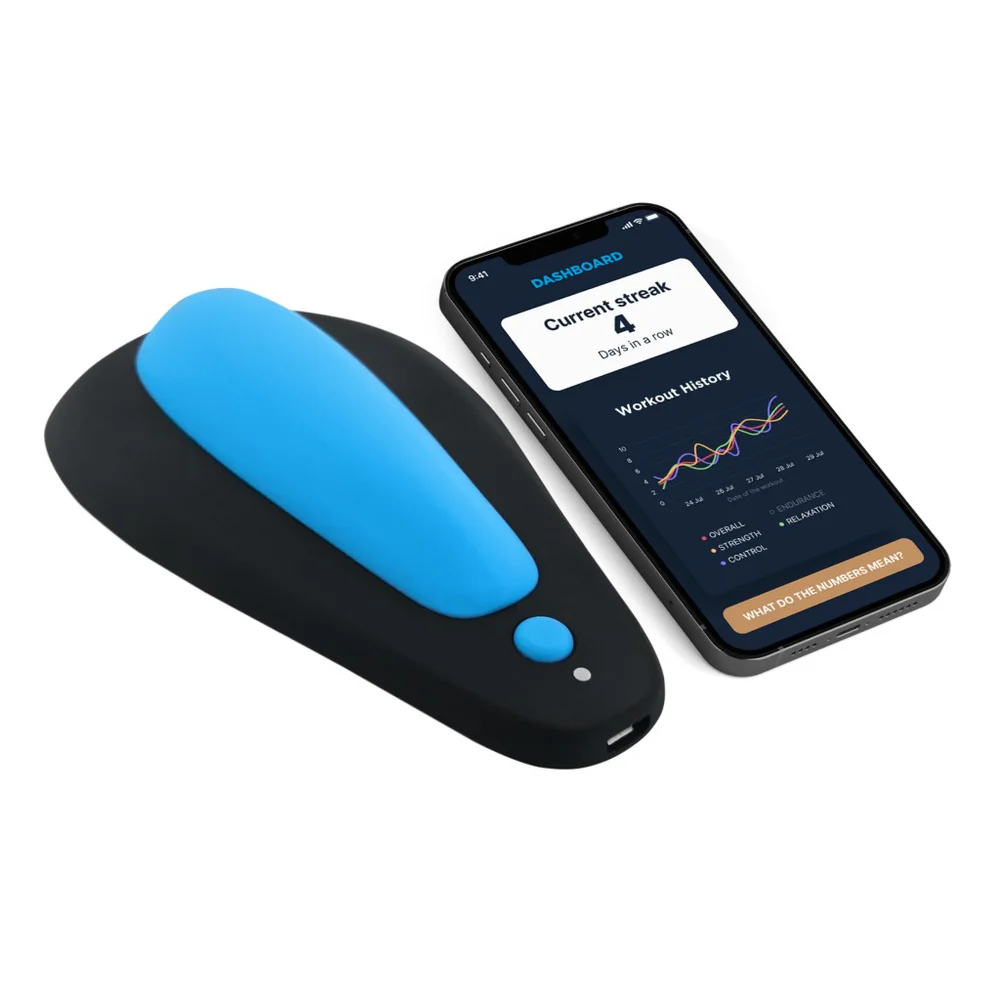Better Breathing For Better Pelvic Floor Exercise
Proper breathing makes Kegels far more effective. This guide shows a simple two-step progression, starting with shallow breaths during holds and advancing to full breathing once the movement becomes automatic. It also includes fixes for breath-holding and chest breathing.
Updated November 26, 2025

If you've been doing your Kegels consistently but not seeing the results you expected, the problem might not be your technique—it could be your breathing.
Many people don't realize that how you breathe during pelvic floor exercises makes a huge difference in how effective they are. Let's talk about why breathing matters and how to get it right.
The Connection Between Breathing and the Pelvic Floor
Diaphragmatic breathing uses your diaphragm—the muscle just under your lungs—to move air in and out of your body.
When you breathe in, your diaphragm expands downward, creating a vacuum that draws air into your lungs. When you breathe out, it moves back up, pushing air out. This type of breathing improves circulation and increases endurance during exercise.
How Your Diaphragm and Pelvic Floor Work Together
Your diaphragm and pelvic floor are both parts of your core and move together like two ends of a piston. During normal breathing, when your diaphragm moves down on an inhale, your pelvic floor gently lengthens downward. When your diaphragm rises on an exhale, your pelvic floor naturally lifts back up.
Here's where Kegels complicate things: you're asking your pelvic floor to contract upward while your diaphragm tries to push it downward during a breath. It's like lifting a weight while someone pushes down on it from above. This is why exhaling makes Kegels easier: your diaphragm rises and stops creating that downward pressure.
Why Is It Hard to Breathe During Kegels?
If you hold your breath during Kegels, you're not alone. You're asking your pelvic floor to contract upward while continuing to breathe normally—and for many people, especially those with weaker muscles, this feels impossible.
Your brain struggles to coordinate two opposing movements simultaneously. Weak muscles make this coordination even harder. When your pelvic floor lacks strength, it takes maximum focus just to contract at all. Adding breathing coordination feels like patting your head while rubbing your stomach.
But, there is good news here: this difficulty is normal and temporary with practice.
Why Breathing Technique Matters for Pelvic Floor Exercise
Diaphragmatic breathing on its own promotes both pelvic floor strength and flexibility.
Many of us spend time with poor posture—slouching on couches or hunched over screens—which leads to shallow chest breathing instead of deep diaphragmatic breathing. Being more intentional about your breathing benefits your pelvic floor immediately.
Beyond that, incorporating proper breathing into Kegels makes the exercise significantly more effective.
Controlled breathing ensures your muscles get adequate oxygen and makes your pelvic floor work smoothly and more naturally. For beginners, especially those who are still learning to identify and engage the correct muscles, calm breathing sets you up for success.
How to Breathe While Doing Kegels: The 2-step progression
Learning how to breathe during Kegels makes the exercise much more effective and prevents breath-holding. Most beginners try to master everything at once. This 2-step progression builds coordination gradually:
Step 1: Exhale and Contract with Shallow Breathing During Holds
- Lie on the floor with support for your head and knees bent. Place one hand on your chest and one on your abdomen below your rib cage
- Take a normal breath in through your nose. Your lower hand should move outward. Your upper hand should barely move
- As you breathe out, slowly contract your pelvic floor. Imagine lifting upward, like drawing a marble up inside your pelvis
- During the hold (3-5 seconds), take small, shallow breaths through your nose. Don't try deep breathing yet—just enough to keep oxygen flowing
- Hold while taking these shallow breaths, then release as you breathe out fully
Pro Tip: Count "1, 2, 3..." out loud while holding. You can't hold your breath while counting.
Step 2: Progress to Normal Breathing Depth
After 1-2 weeks, your brain automates the contraction.
- Now, gradually increase breath depth during holds. Take fuller breaths through your nose while maintaining your pelvic floor lift
- This will feel strange initially. If you lose the contraction, return to shallow breathing for more practice
- Try to use visualization if you're struggling. Imagine your pelvic floor as a jellyfish floating upward, staying lifted even as water (breath) flows around it
Once you can maintain a Kegel through 3-5 full breaths, you've mastered the coordination.
Common Breathing Problems and Solutions
- Can't Breathe and Contract Simultaneously: Start simpler—do your Kegel entirely during one long exhale (5-7 seconds), then fully release. Practice this for one week before adding holds with shallow breathing
- Unconsciously Holding Breath: Count out loud or hum during holds. When you stop making sounds, you're holding your breath
- Feel Downward Pressure on Inhale: You're breathing too deeply, too soon. Return to very shallow breaths and check hand placement—your lower abdomen should expand, not your upper chest
- Neck and Shoulder Tension: This indicates chest breathing. Your shoulders shouldn't rise during inhalation. Practice diaphragmatic breathing alone until your shoulders stay relaxed, then add the Kegel
- Lose Contraction When You Inhale: Reduce contraction intensity to 50-60% effort. Lighter contractions are easier to maintain while breathing and build strength just as effectively
Breathing for Pelvic Floor Relaxation (Beyond Kegels)
Not everyone needs to strengthen their pelvic floor. If you have pelvic pain, painful sex, difficulty starting urination, or chronic constipation, your muscles might be too tight—a condition called hypertonic pelvic floor. These muscles need to learn relaxation, not more contraction.
Diaphragmatic breathing helps release chronically tight pelvic floor muscles without any Kegel contraction.
Breathing for Tension Release
- Lie on your back with knees bent
- Take slow, deep breaths in through your nose for 4-5 seconds, expanding your lower abdomen
- Your pelvic floor gently lengthens downward
- Exhale slowly through your mouth for 6-7 seconds, letting your abdomen fall naturally
Practice 5-10 minutes daily. Many people notice decreased pain within 2-3 weeks.
Reverse Kegels With Breathing
On your inhale, gently "bear down"—like starting to urinate (but don't actually). This actively lengthens your pelvic floor. Hold for 3-5 seconds while breathing normally, then release on exhale.
Who Benefits from Reverse Kegels
Anyone with pelvic pain, painful sex, urinary urgency despite no infection, or symptoms that worsen with regular Kegels. If unsure whether you need strengthening or relaxation techniques like down training, consult a pelvic floor physical therapist [1].
Applying Breathing in Daily Life
- Exhale Before Sneezing or Coughing: That split-second before you sneeze, quickly exhale and engage your pelvic floor. This prevents most stress incontinence leaks
- Breathe During Lifting: Exhale as you lift while engaging your pelvic floor. Never hold your breath—this creates dangerous abdominal pressure
- "Blow Before You Go": Take 2-3 deep breaths before using the bathroom. This relaxes your pelvic floor for easier, more complete emptying
- During Other Exercises: Exhale during the hard part (lifting, jumping) while engaging your pelvic floor. Inhale during the easier phase
Mastering Breathing for Better Kegel Results
Diaphragmatic breathing benefits your overall health beyond pelvic floor function, so practice this breathing style anytime, especially during pelvic floor exercises.
If you're struggling to coordinate breathing with proper technique, kGoal Classic provides real-time biofeedback showing exactly when you're engaging correctly—even while breathing.
The adjustable design ensures comfort during practice. kGoal Boost works externally for both men and women, tracking engagement without insertion, so you can focus on mastering breathing coordination.
References
Cronkleton, E. (2022, September 1). What is pelvic floor relaxation, and why should I do it? Healthline. https://www.healthline.com/health/fitness-exercise/reverse-kegel
Disclaimer: This article is for informational purposes only and is not intended as medical advice. Always consult a qualified healthcare provider before starting any new treatment or if you experience persistent bladder symptoms.
FAQs
Why is it hard to breathe during Kegels?
Your diaphragm pushes down when you inhale while your pelvic floor contracts upward during a Kegel—these are opposing movements. Weak pelvic floor muscles make coordination even harder because it takes maximum focus just to contract them. This difficulty is normal and temporary; the 2-step breathing progression builds coordination gradually.
Should I breathe in or out during Kegels?
Breathe out when you initially contract your pelvic floor—exhaling stops your diaphragm from pushing downward. During the hold phase, continue breathing (start with shallow breaths, and progress to deeper breaths as coordination improves). Never hold your breath throughout an entire Kegel.
Why do I hold my breath during Kegels?
Breath-holding happens when you're concentrating intensely on an unfamiliar movement. Your brain can't coordinate breathing and pelvic floor contraction simultaneously yet. The solution: count out loud or hum during holds—you can't hold your breath while making a sound.
How do I know if I'm breathing correctly during Kegels?
Place one hand on your chest and one on your lower abdomen. During inhalation, your lower abdomen should expand while your chest barely moves. If your shoulders rise or your upper chest moves first, you're chest-breathing instead of using your diaphragm. Reset to diaphragmatic breathing practice alone before adding the Kegel.
Can you do Kegels without holding your breath?
Yes—and you should. Breath-holding creates unhealthy pressure in your abdomen and thorax, increases blood pressure temporarily, and prevents your muscles from getting adequate oxygen. The 2-step breathing progression specifically trains you to maintain breathing throughout your Kegels.
What is diaphragmatic breathing for pelvic floor?
Diaphragmatic breathing is breathing that fully engages your diaphragm muscle (located below your lungs) rather than shallow chest breathing. When you breathe this way, your lower abdomen expands on inhale and contracts on exhale. This breathing pattern supports pelvic floor health by maintaining natural coordination between your diaphragm and pelvic floor muscles, promoting both strength and flexibility.
How long does it take to master breathing during Kegels?
Most people develop basic coordination within 2-3 weeks of consistent practice. Full mastery—where breathing feels completely automatic during Kegels—typically takes 6-8 weeks. Progress faster by practicing daily for even 5 minutes, and don't skip the shallow-breathing phase.
Should I do Kegels if my pelvic floor is too tight?
No—traditional strengthening Kegels can worsen symptoms if you have a hypertonic (too-tight) pelvic floor. Instead, practice diaphragmatic breathing for relaxation and reverse Kegels. Consult a pelvic floor physical therapist to confirm whether you need strengthening or relaxation work.








